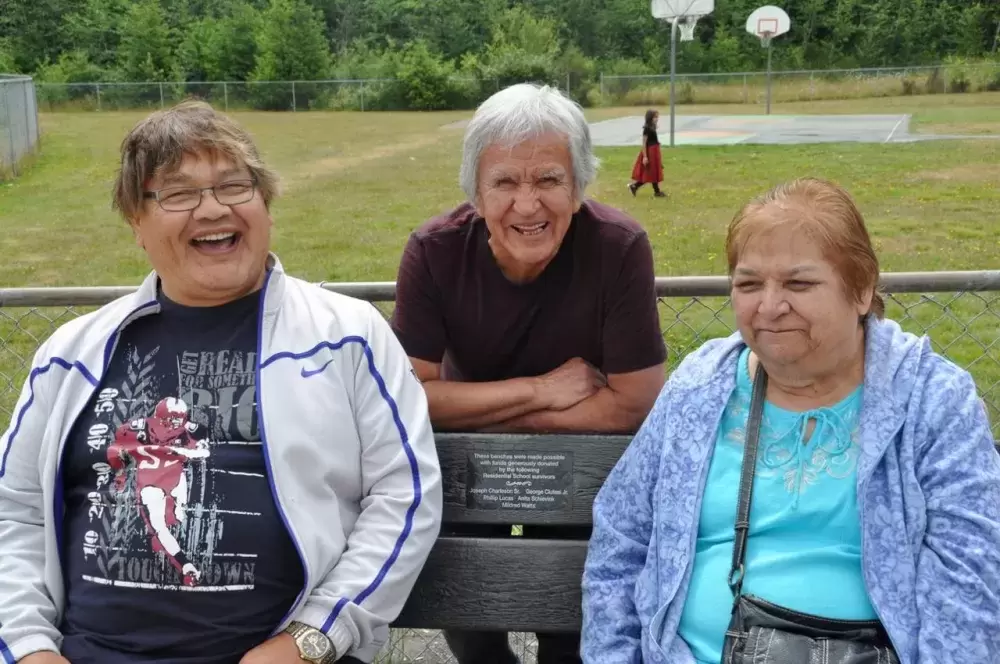Staff and students at Haahuupayak School held a ribbon-cutting ceremony June 22 to honour five residential school survivors who made a significant contribution to the school.
When the Indian Residential School Survivors Settlement was finally paid out, Joe Charleson Sr., Phillip Lucas, George Clutesi Jr., Anita Schievink and Millie Watts each donated their personal education credits (for a total of $14,500) to Haahuupayak.
Charleson, Lucas and Watts were able to attend the event to introduce two commemorative benches now installed in the school playground.
The benches, built of textured concrete, were purchased with a portion of the donation.
At 11:30 a.m., students assembled in the schoolyard, carrying drums and wearing headdresses. To open the ceremony, instructor Trevor Little led his students in a ciiqaa (prayer chant).
Following the singing, Nuu-chah-nulth Studies teacher Lena Ross led the students in giving a round of thanks toelder Kathy Robinson, who composed the chant and gave permission for the school to use it.
Ross then led the students in a round of thanks to the survivors.
“It wasn’t just these two benches,” Little noted. “These were the last of the donation.”
The funds were used to purchase a pair of raven masks, to conduct an eagle workshop, to purchase basketball jerseys and drumsticks, field trips to Ditidaht and to the Broken Islands, shawls, tunics, cedar headbands and a Narrator hat.
“Many things; lots of money; spent for you,” Little told the students.
All gathered at the entrance to the playground. Haahhuupayak Hummingbirds Grace Sarlandie and Adriana Watts held the ribbon while Michelle Frank applied the scissors.
Following the ribbon cutting, Little led the students in a spirited rendition of the Haahuupayak Song.
“This [donation] has been huge for us,” Little told Ha-Shilth-Sa. “In a private school, with limited funding… this made our year.”
One of the new benches bears a plaque with the names of the five donors. Easing back into the bench, survivor Phillip Lucas said his residential school experience was short and sharp.
“I was in Christie School for seven terms. That was the end of my education,” he observed. “After I turned 16, I was able to stay home.”
Lucas said his parents managed to keep him out of the school until he was 10, so by age 16, his actual schooling was pretty sketchy.
For Haahuupayak principal Gio Mussato, who retires at the end of the school year, the bench dedication marks the culmination of a personal learning experience.
“I went to A.W. Neill with students who had gone to the [Alberni Indian] residential school. I didn’t know that. I was an immigrant,” he said. “Some of my first friends when I came to Canada were First Nations.”
Mussato said it was many years before he learned what many of those friends couldn’t talk about.
“Coming to Haahuupayak, and more importantly, the Truth and Reconciliation process, has brought me to a greater understanding,” he said.
Haahuupayak board chair Martin Watts said the benches are a reminder of past unhappiness, but also represent the strength and resiliency of the survivors.
“It shows a lot of love and care that people have for children, their grandchildren and other people’s grandchildren,” he said “A lot of them lost their childhood, and now they are giving back to children.”
Watts said his late grandmother, Martha Fred, was a strong supporter of the school, because a major focus was on teaching the Nuu-chah-nulth language, which she knew was critical in maintaining cultural identity.
“Now these kids have that opportunity and we see them thrive. They are a lot more comfortable in who they are.”
Watts said the success of Haahuupayak students affirms the vision of its founders.
“The best thing we could have done was build this school,” he said.







